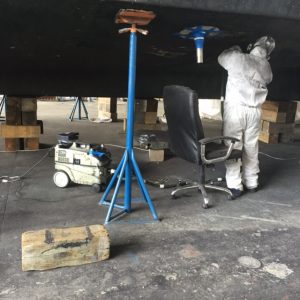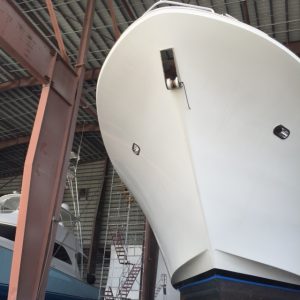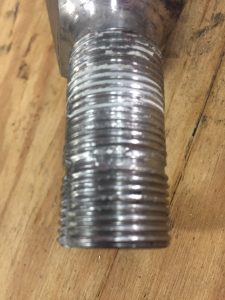A 106’ Westport yacht was recently hauled at Lauderdale Marine Center for a variety routine maintenance projects including shaft work, bearing replacements and an overhaul on several hydraulic systems. To streamline the process and help the captain and crew better manage the project, they contracted with both High Seas Yacht Service for the running gear portion and High Seas Hydraulics to handle the hydraulics work.
 Our running gear mechanics inspected the shafts to ensure they were straight and aligned and replaced the bearings and seals. Normal wear and tear associated with running the vessel and prolonged exposure to salt water makes this task a necessary evil for properly maintaining the boat. As seen in the adjacent photo, there was a visible gap where the cutlass bearing adjoined to the shaft.
Our running gear mechanics inspected the shafts to ensure they were straight and aligned and replaced the bearings and seals. Normal wear and tear associated with running the vessel and prolonged exposure to salt water makes this task a necessary evil for properly maintaining the boat. As seen in the adjacent photo, there was a visible gap where the cutlass bearing adjoined to the shaft.
We were also commissioned to replace the seals on the lower stabilizer fins. ABT Trac, one of the more popular brands,  recommends changing the lower stabilizer fin seals every couple of years but at least every six years depending on use. The components on the stabilizer are constantly working except is absolute calm seas, so the wear and tear can be considerable. After dropping the fins, we proceeded to change out the old lower stabilizer fin seals with new ones, check the hoses and cylinders, then reassembling the units.
recommends changing the lower stabilizer fin seals every couple of years but at least every six years depending on use. The components on the stabilizer are constantly working except is absolute calm seas, so the wear and tear can be considerable. After dropping the fins, we proceeded to change out the old lower stabilizer fin seals with new ones, check the hoses and cylinders, then reassembling the units.
In addition to the routine maintenance on the stabilizer systems, we flushed the entire hydraulic system using the simple drain, filter, fill approach commonly referred to in our shop as a DFF. This type of flush is more of an “oil change” and is part of routine maintenance. It is not appropriate where a more serious condition such as water, metal particles or other contaminants are found in the oil. The process calls for draining the hydraulic tank, changing out the filters and refilling the tank with hydraulic fluid.
 To round out the work on this Westport, we did an overhaul on the bow thruster, single Maxwell windlass, the boat’s heat exchangers and the hydraulic steering system which was slow to respond.
To round out the work on this Westport, we did an overhaul on the bow thruster, single Maxwell windlass, the boat’s heat exchangers and the hydraulic steering system which was slow to respond.
From running gear to hydraulics, our teams at High Seas Yacht Service and High Seas Hydraulics, make easy work of maintaining the systems that make your vessel safe and operating smoothly.








